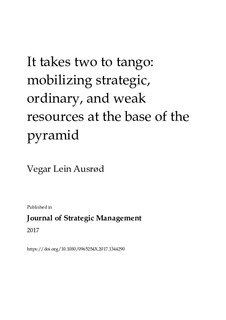It takes two to tango: mobilizing strategic, ordinary, and weak resources at the base of the pyramid
Journal article, Peer reviewed
Accepted version
Permanent lenke
http://hdl.handle.net/11250/2493418Utgivelsesdato
2017Metadata
Vis full innførselSamlinger
Sammendrag
Entrepreneurs are often resource-constrained from the beginning. Entrepreneurs at the base of the pyramid (BoP) face an additional challenge: the context in which they operate is also lacking in resources, at least strategic resources that contribute competitive advantage. Nevertheless, firms in a BoP context are urged to become socially embedded and build on the present resources and conditions. This implies a resource mobilization process and joint value creation. Using a single case study of an electricity firm operating in rural India, this research investigates how entrepreneurs can mobilize strategic, ordinary, and weak resources through social embeddedness at the BoP. The research discloses three new actions related to become socially embedded – enticing customers, selective attention, and supplier responsiveness. It thus contributes theoretically to the social embeddedness perspective and the BoP literature. Moreover, it contributes theoretically to the resource-based view (RBV) theory and the resource mobilization perspective in suggesting that there is more room to socially embed ordinary and weak resources. As a result, they become more valuable compared to strategic resources, which exhibit less room for becoming socially embedded and therefore become less valuable. Consequently, the findings challenge the RBV and the valuable, rare, inimitable, and non-substitutable (VRIN) labeling of resources.
